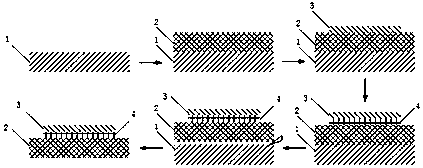A method for preparing silicene film by mechanical exfoliation and application of silicene film
A technology of mechanical exfoliation and silicene, applied in chemical instruments and methods, inorganic chemistry, silicon compounds, etc., can solve the problems of high cost of silicene, unsuitability for large-scale industrial production, increase of metal thin films and substrate materials, etc., and achieve environmental protection Less pollution, environmental friendliness, and the effect of reducing production costs
- Summary
- Abstract
- Description
- Claims
- Application Information
AI Technical Summary
Problems solved by technology
Method used
Image
Examples
Embodiment 1
[0042] Such as figure 1 As shown, the method steps of the silicene film prepared by mechanical peeling in the present invention are as follows:
[0043] (1) Select a Si (111) silicon wafer with a diameter of 50 mm and a thickness of 0.1 mm as the silicon source, wash it with SPM solution at a temperature of 80 °C for 5 minutes, rinse it with deionized water, and then ultrasonicate it in HF solution for 1 Minutes to remove the silicon oxide on the surface of the silicon wafer, and finally rinse with deionized water to remove the residual HF liquid, and dry the surface of the silicon wafer with hot nitrogen. Among them, the SPM solution is H 2 SO 4 :H 2 o 2 =1:4 strong oxidizing solution, the concentration of HF solution is 3.5%, the hot nitrogen is nitrogen with a purity of 99.9%, and the temperature is 80°C.
[0044] (2) Take out the processed Si wafer and put it into a vacuum chamber. The temperature of the Si wafer is at room temperature, and the background vacuum degre...
Embodiment 2
[0050] (1) Select a Si (111) silicon wafer with a diameter of 70 mm and a thickness of 0.2 mm as the silicon source, wash it with SPM solution at a temperature of 80 °C for 5 minutes, rinse it with deionized water, and then ultrasonicate it in HF solution for 1 Minutes to remove the silicon oxide on the surface of the silicon wafer, and finally rinse with deionized water to remove the residual HF liquid, and dry the surface of the silicon wafer with hot nitrogen. Among them, the SPM solution is H 2 SO 4 :H 2 o 2 =1:4.5 strong oxidizing solution, the concentration of HF solution is 4%, the hot nitrogen is nitrogen with a purity of 99.9%, and the temperature is 85°C.
[0051] (2) Take out the processed Si wafer and put it into a vacuum chamber. The temperature of the Si wafer is at room temperature, and the background vacuum degree of the coating is 1.0×10 -3 Pa, using resistance wire evaporation, using a crystal oscillator to monitor the coating process, setting the evapora...
Embodiment 3
[0057] (1) Select a Si (111) silicon wafer with a diameter of 80 mm and a thickness of 0.25 mm as the silicon source, wash it with SPM solution at a temperature of 80 °C for 5 minutes, rinse it with deionized water, and then ultrasonicate it in HF solution for 1 Minutes to remove the silicon oxide on the surface of the silicon wafer, and finally rinse with deionized water to remove the residual HF liquid, and dry the surface of the silicon wafer with hot nitrogen. Among them, the SPM solution is H 2 SO 4 :H 2 o 2 =1:5 strong oxidizing solution, the concentration of HF solution is 4.5%, the hot nitrogen is nitrogen with a purity of 99.9%, and the temperature is 85°C.
[0058] (2) Take out the processed Si wafer and put it into a vacuum chamber. The temperature of the Si wafer is at room temperature, and the background vacuum degree of the coating is 1.0×10 -3 Pa, using sputtering method for coating, using Mo metal target, using a crystal oscillator to monitor the coating pr...
PUM
| Property | Measurement | Unit |
|---|---|---|
| thickness | aaaaa | aaaaa |
| thickness | aaaaa | aaaaa |
| diameter | aaaaa | aaaaa |
Abstract
Description
Claims
Application Information
 Login to View More
Login to View More - R&D
- Intellectual Property
- Life Sciences
- Materials
- Tech Scout
- Unparalleled Data Quality
- Higher Quality Content
- 60% Fewer Hallucinations
Browse by: Latest US Patents, China's latest patents, Technical Efficacy Thesaurus, Application Domain, Technology Topic, Popular Technical Reports.
© 2025 PatSnap. All rights reserved.Legal|Privacy policy|Modern Slavery Act Transparency Statement|Sitemap|About US| Contact US: help@patsnap.com


